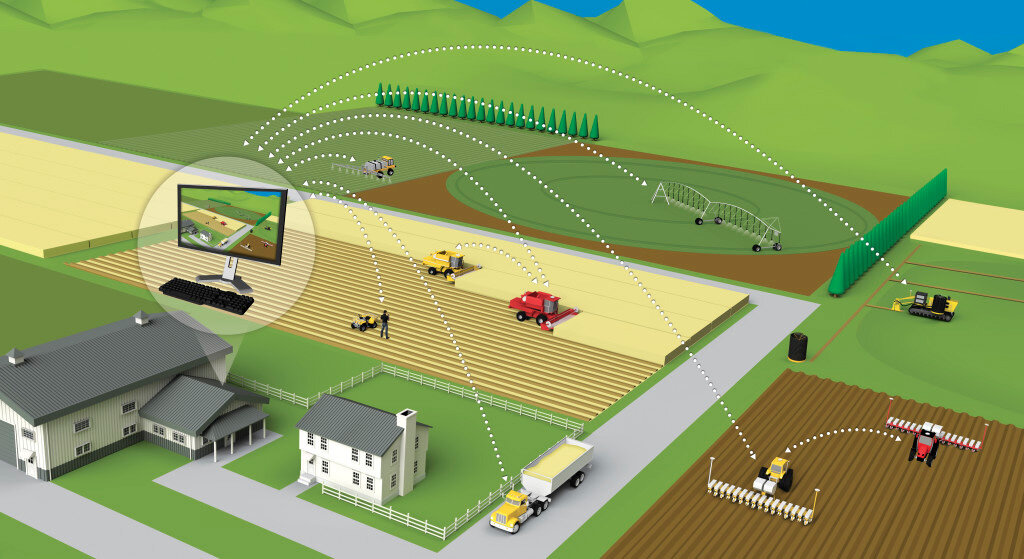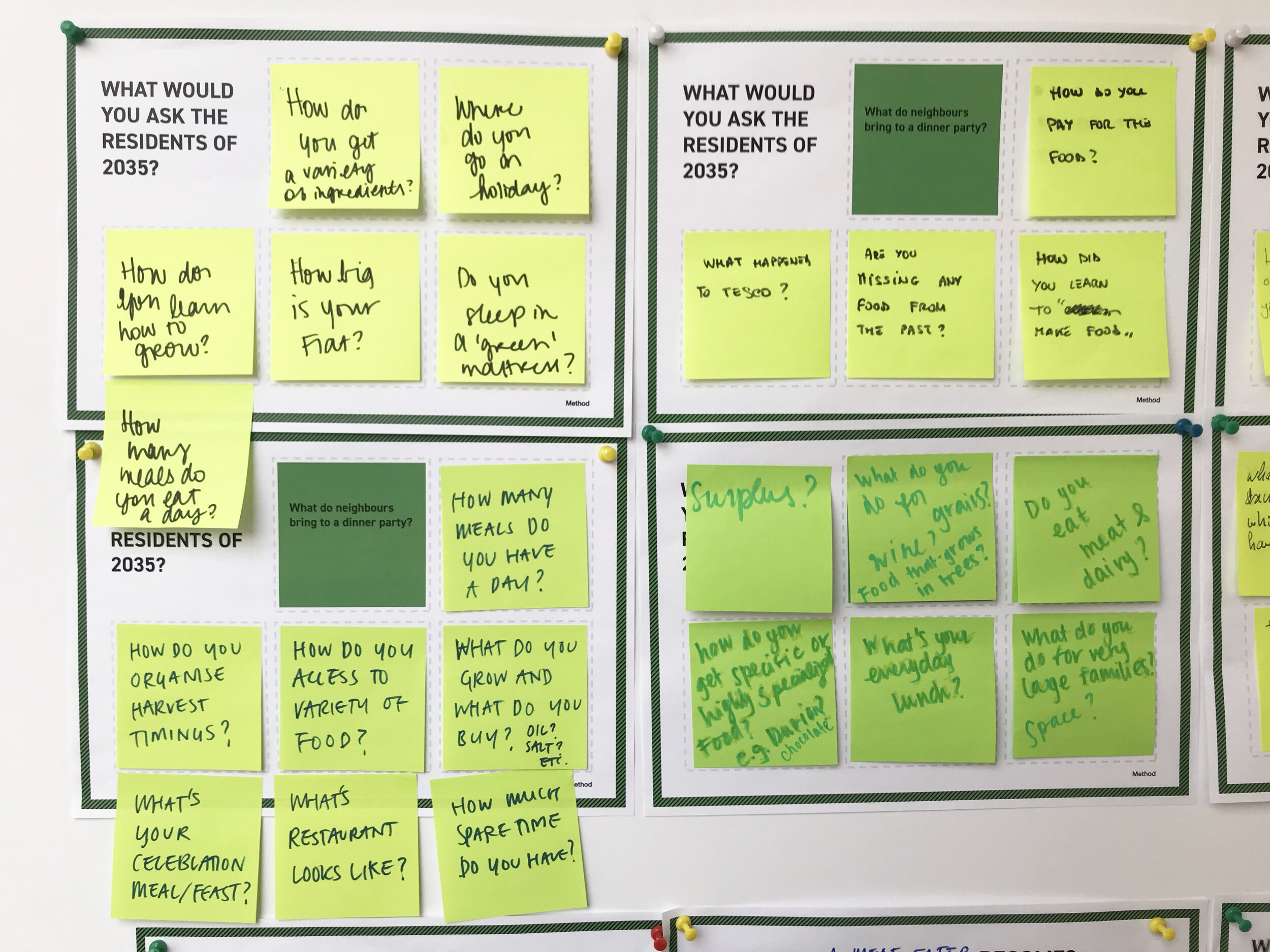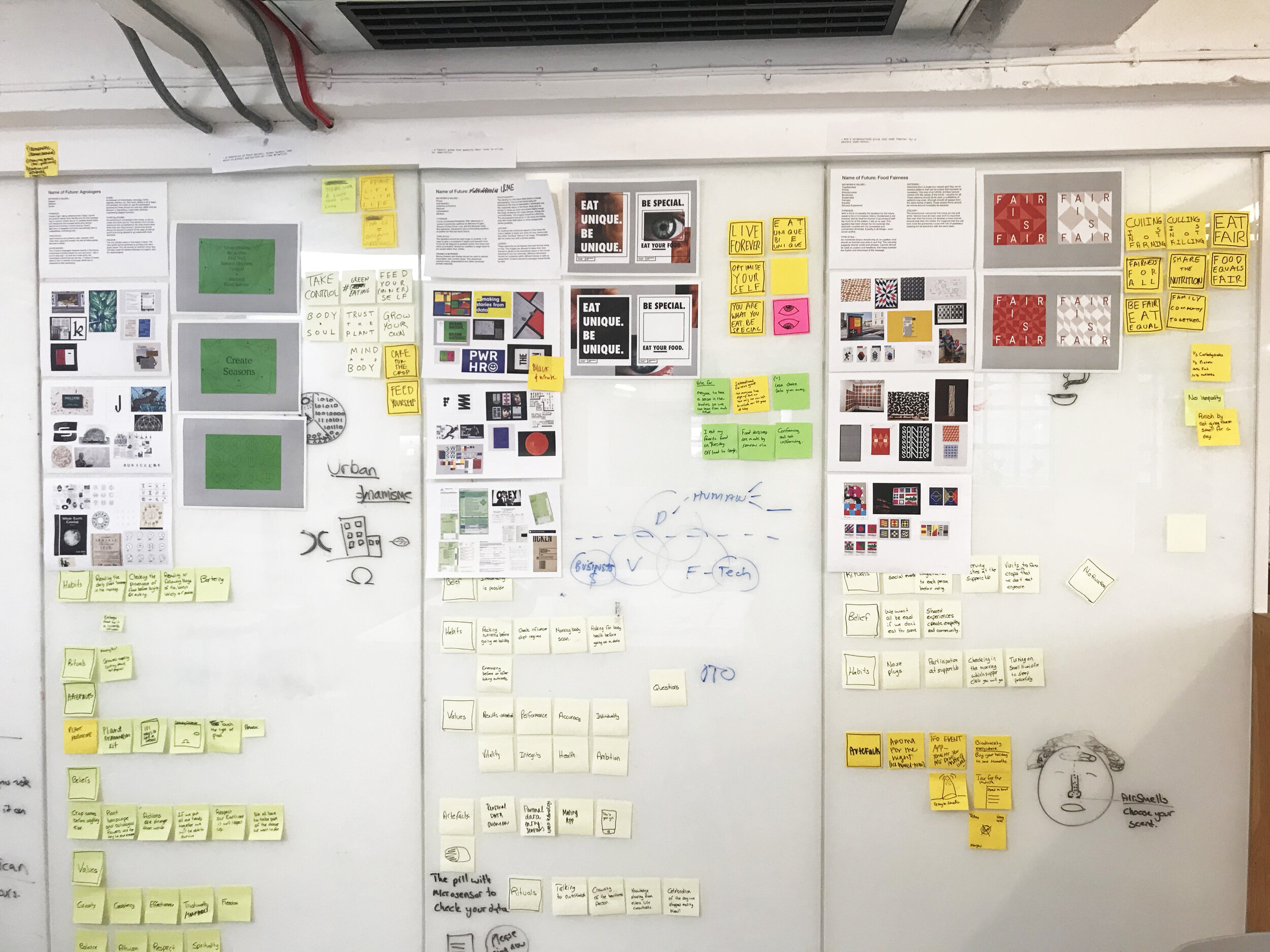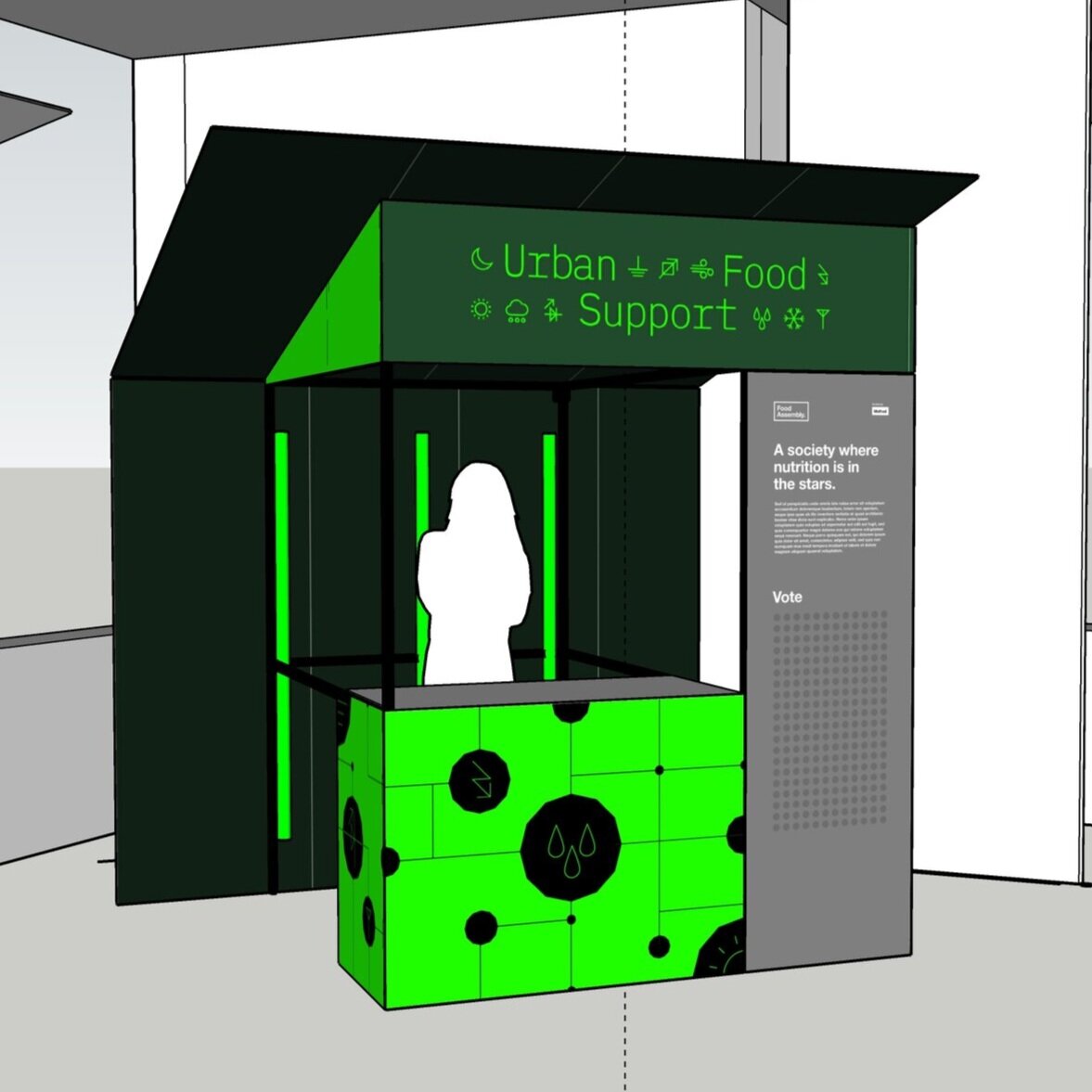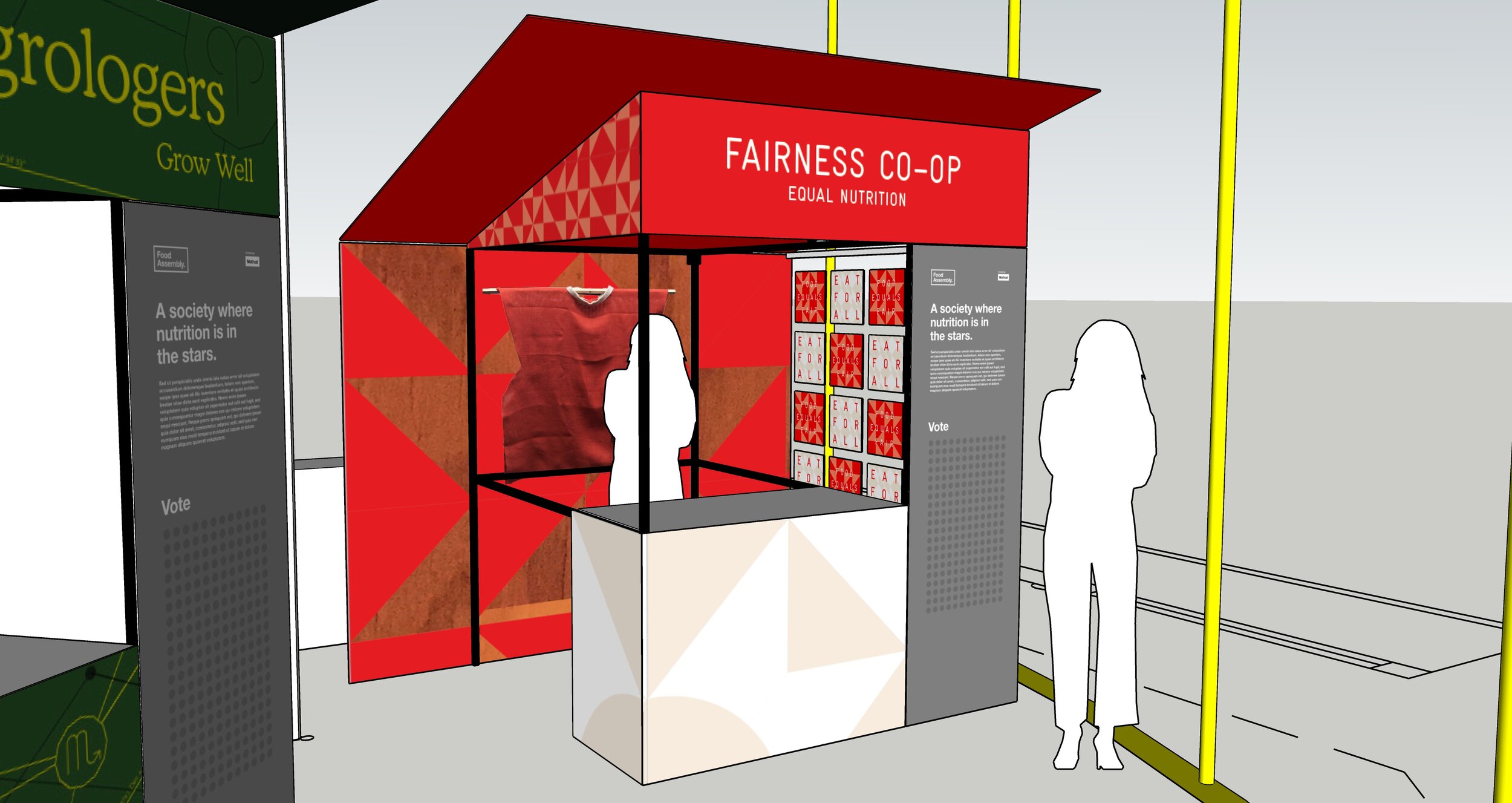Client
Exploratory Project:
Food Assembly
Agency
Method Inc.
Core Team
Ana Soto
Adrian Kraus
Luke Thompson
David Mayman
Joshua Leigh
Expertise & Skills
Speculative Design
Storytelling
Prototyping
Location
Barbican Centre
London, UK
Summer 2019
Opportunity
Climate change is warming our planet, population numbers are increasing exponentially, and soil nutrition is diminishing. It’s clear that the way we produce, distribute, and consume our food must radically change, but how?
Can radical future scenarios help us make better decisions today?
Solution
To promote productive conversation, we created the Food Assembly — a three-day immersive exhibition at the Barbican Centre in London exploring the future of food and our agricultural system. We developed three radically different future scenarios as a proxy to encourage debate about the big questions we face today.
Acting as a representative of each future community, we immersed visitors in experiential storytelling about the new norms of everyday life and showcased future artefacts. We asked the 900+ people that visited the exhibition to vote for the future they’d prefer to live in, and collected their thoughts on how they would change the present food system. The speculations were meant to provoke a debate around the possible and the probable future of our food systems.
Media Coverage
Together with James Steiner, I gave a talk at the London Design Museum during the Service Design Fringe Festival, the first and only service design festival in London. The talk examined how to envision services of the future and the use of the design process & storytelling to stimulate complex conversations.
In addition, The Food Assembly was covered by BBC Click for an episode around the future of food.
Extrapolating trends into possible scenarios
Drawing on macro-themes from our agricultural trend research, we used speculative thinking to extend what may be plausible and possible. We took a macro-trend (eg. increase in population predicted to happen) and paired it with an agriculture trend (eg. the growing consumer trend of understanding food origin).
We collected these ideas into three loose directions to explore how we might grow, distribute, process and consume food in the future.
Co-creative workshops to build speculative future scenarios
Using these future directions as a baseline, we invited experts in a variety of fields such as urban farming, agri-tech, blockchain, and investment fund management to further each future using a co-creative process.
Teams generated questions to ask the residents of the future, and then proceeded to answer them. Through a series of creative exercises, three food-related communities of the future were born. For some of the participants this was a completely new way of thinking and using their creativity. Participants imagined their brands – down to their values, rituals, and uniforms.
The way we eat is deeply connected to many aspects of our society - from culture, transportation and even love, so these speculative worlds touched more aspects than just food.
Developing the futures
With the core design team we went on to further develop the details of the community:
What do they believe in?
How do they behave?
Do they have different habits?
As well as the associated food service these communities stand for and how these might be represented visually.
Producing the exhibit
We produced the exhibit in our studio; everything from painting to building the market stands, the print materials and artefacts. It was a joint effort where everyone got involved.
As part of the core team, I participated throughout the whole speculative design process and while building the exhibit I was the producer managing the different tasks.
Provoking diverse debate and learning through extreme future scenarios
The Food Assembly imagines communities from three radical futures, and explores how we might address some of our civilization's hardest challenges. The three radically different future scenarios we developed were meant to be a proxy to encourage debate about the big questions we face today.
None of these futures were meant to be comfortable, and we know there is no easy answer to these extremely difficult questions. The objective was to push people out of their comfort zone to stimulate debate. We weren’t trying to predict the future, and so the project was framed as a timeline splitting into three possibilities.
Three speculative future communities pitching their belief system
We created three stands, one per future, and each had its own representative pitching their services and set of beliefs to gain votes. Visitors would go to each stand, hear what the representatives had to say and then make up their mind to vote for the future they would prefer to live in.
We immersed visitors through stories sharing the new norms of everyday life and illustrated each with its representative artefacts. The futures were built to have both positive and negative aspects to spark critical debate. At times, they are extreme but the purpose is to challenge the notions we think are permanent and take for granted. For example, the idea that we will always have supermarkets that sell pineapples and bananas all year round.
Future 1 - Me&I®
Future 2 - Urban Food Support
Future 3 - Fairness Co-Op
Future 1 —
What impact will technology have on our food system?
Me&I®, a technology-first food supplier that believes hyper-personalized nutrition, offers subscription based genetically engineered meals. Would you relinquish control over what you eat with the promise of longevity?
This future is based on trends on the quantified self and the proteus pill, the first FDA approved digital pill.
Oral Sensor — A device to monitor the user’s saliva and analyzes what he or she eats to prescribe the best meals
Gastro-sensor — Users could eat this sensor to provide stomach and gut data to optimise digestion and the absorption of nutrients
Meal Protocol System — Delivery of tailored made meals optimised for the user
Future 2 —
How will hyper-urbanisation and depleting resources impact what we eat?
Urban Food Support exists in an era of mass urbanization and the collapse of a reliable food system. The world’s urban citizens look to themselves to produce their food, but the lack of expertise and governance has given rise to coercion. Would you rely solely on your neighbours to grow the food you eat?
This future is based on urban farming trends and an increase consumer interest on food provenance, as well as the growth in genetically modified food and developments like lab grown meat.
Seed DNA Testing Device — Citizens use seed DNA testing devices to verify the origin and contents of seeds before purchase and trading
Product Recall Safety Notice — Distributed by UFS for citizens to be aware of contaminated seeds and black market offerings
Personal Food Computer — Enclosed chamber that replicates growing conditions to grow almost any crop desired. Allowing citizens to grow more variety of food in the city
Future 3 —
How will we effectively feed a growing middle class?
The Fairness Co-op is a local organization seeking to solve the resource crisis of our 10 billion-person planet. They believe that a fair and equal lifestyle lies in ensuring we all eat the same thing: MonoMeal™. Would you give up culinary diversity to ensure complete fairness?
This future is based on meal alternatives trends and developments like Huel and Solent, as well the universal basic income.
MonoMeal — Nutritionally balanced meal for everyone to eat, helping achieve fairness for the entire population
MonoMeal™ Moulds — Given the smooth texture of MonoMeal™ citizens look at ways to change the mouth feel using moulds to add textures and shapes
Olfactory Simulation Device — Neighbors, families and friends get together in Supper Clubs to enjoy the MonoMeal™, they use this olfactory device to stimulate other senses while eating it
Novel ideas are born from diverse discussions
The ubiquitous nature of food as a topic made it easy for anyone to engage in discussion around challenging subjects. Many people were emotionally charged, and found themselves defending beliefs they may not have known they were so passionate about.
The stories we created were rich but intentionally narrow, which invited people to mould and bend them along with us during our conversations. Participants were unknowingly co-opted into becoming speculative designers as soon as they began playing along with the performance.
Urban Food Support received the most votes primarily because it resembles the most “natural” path.
What we learned from the project?
01
Storytelling, role play and physicalizing experiences through artefacts are effective methods to help people imagine and respond to abstract concepts.
02
Extrapolating current trends can help us to understand people’s values of today, envision future scenarios and imagine possible needs that may not yet exist.
03
Inviting the public into the conversation helps to trigger debate and enables people to think and reflect on the impact they can have on society through their actions and attitudes.




